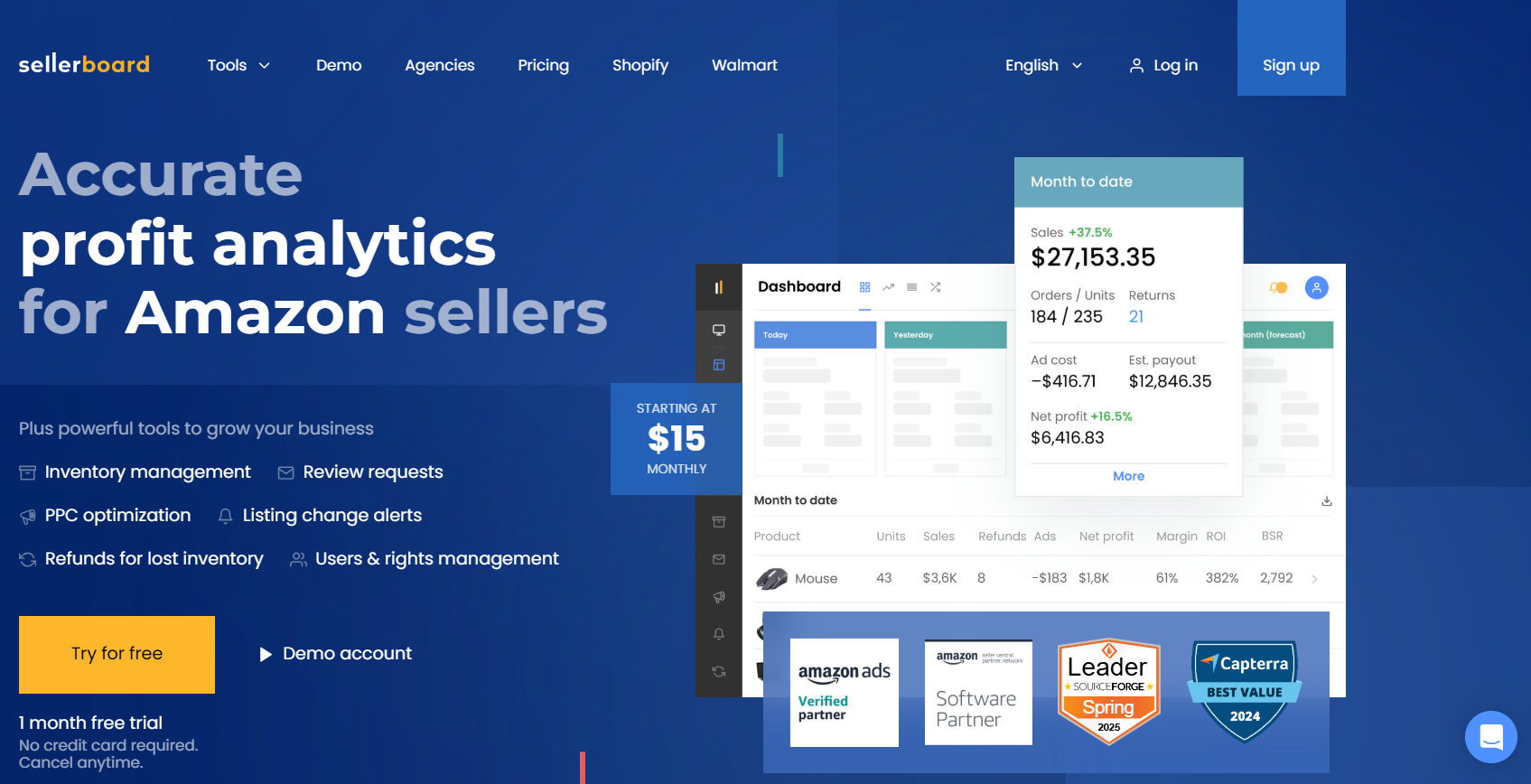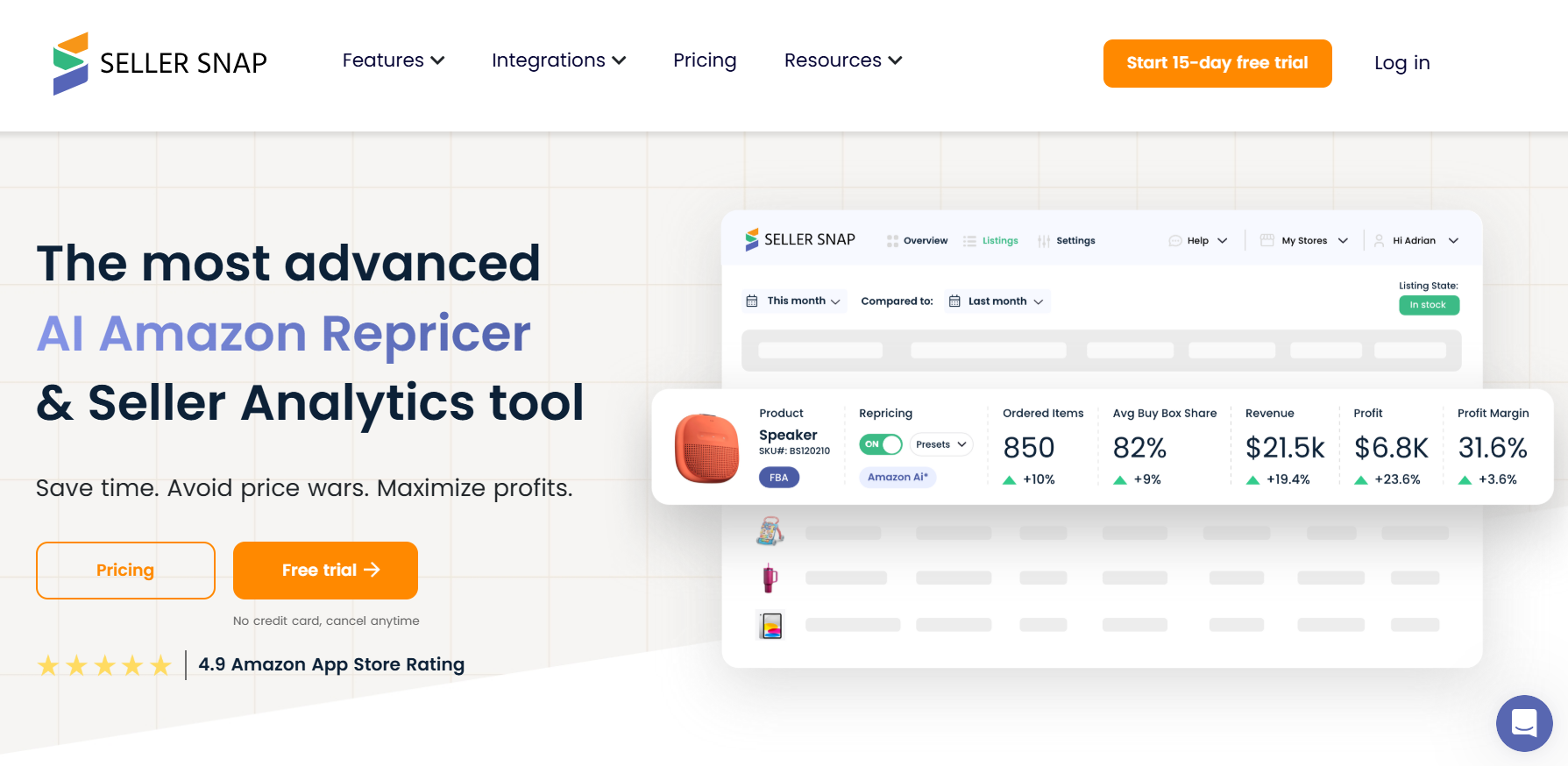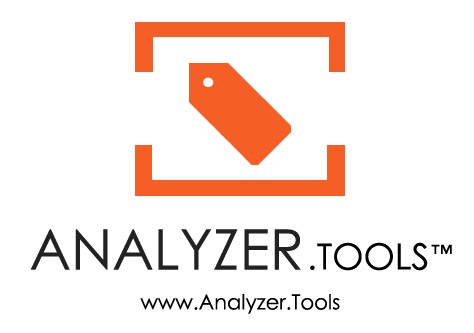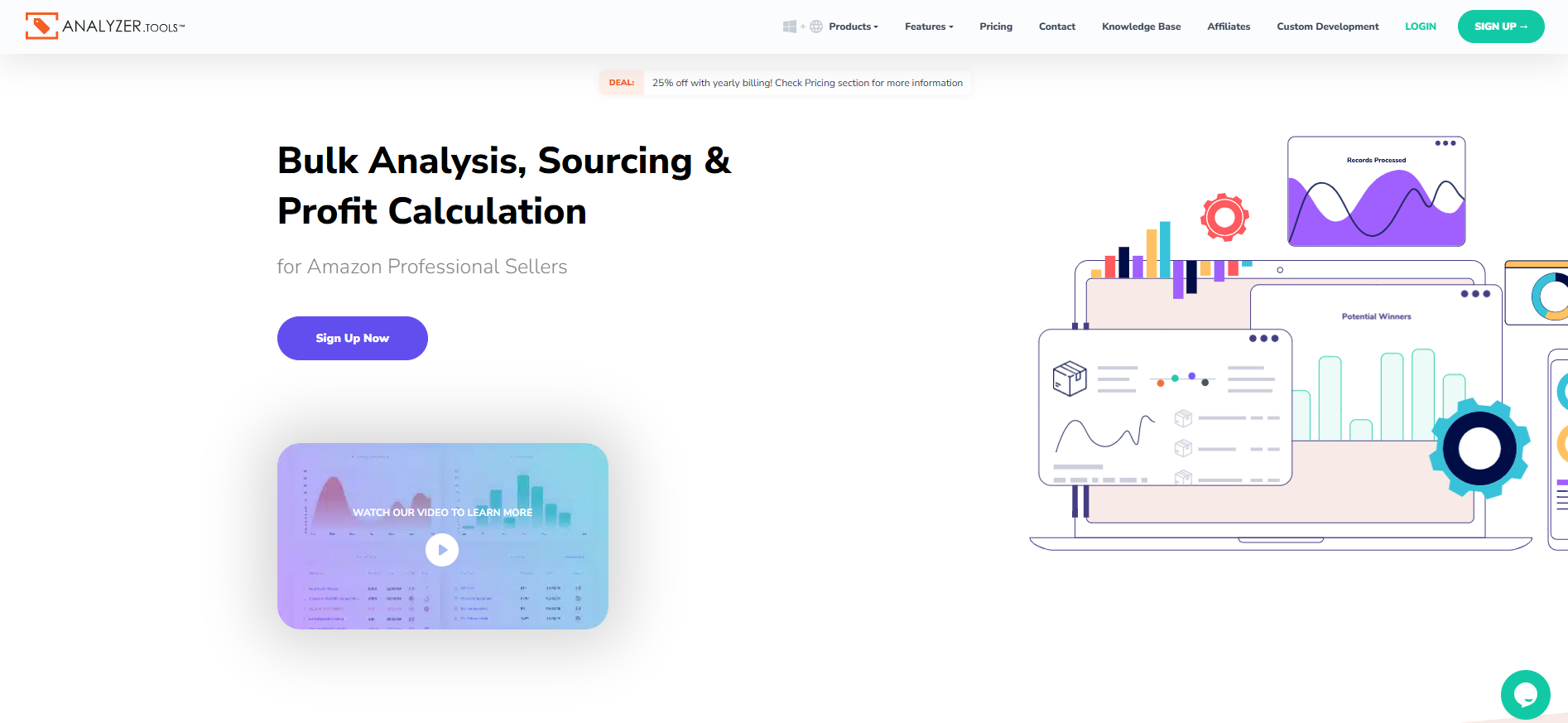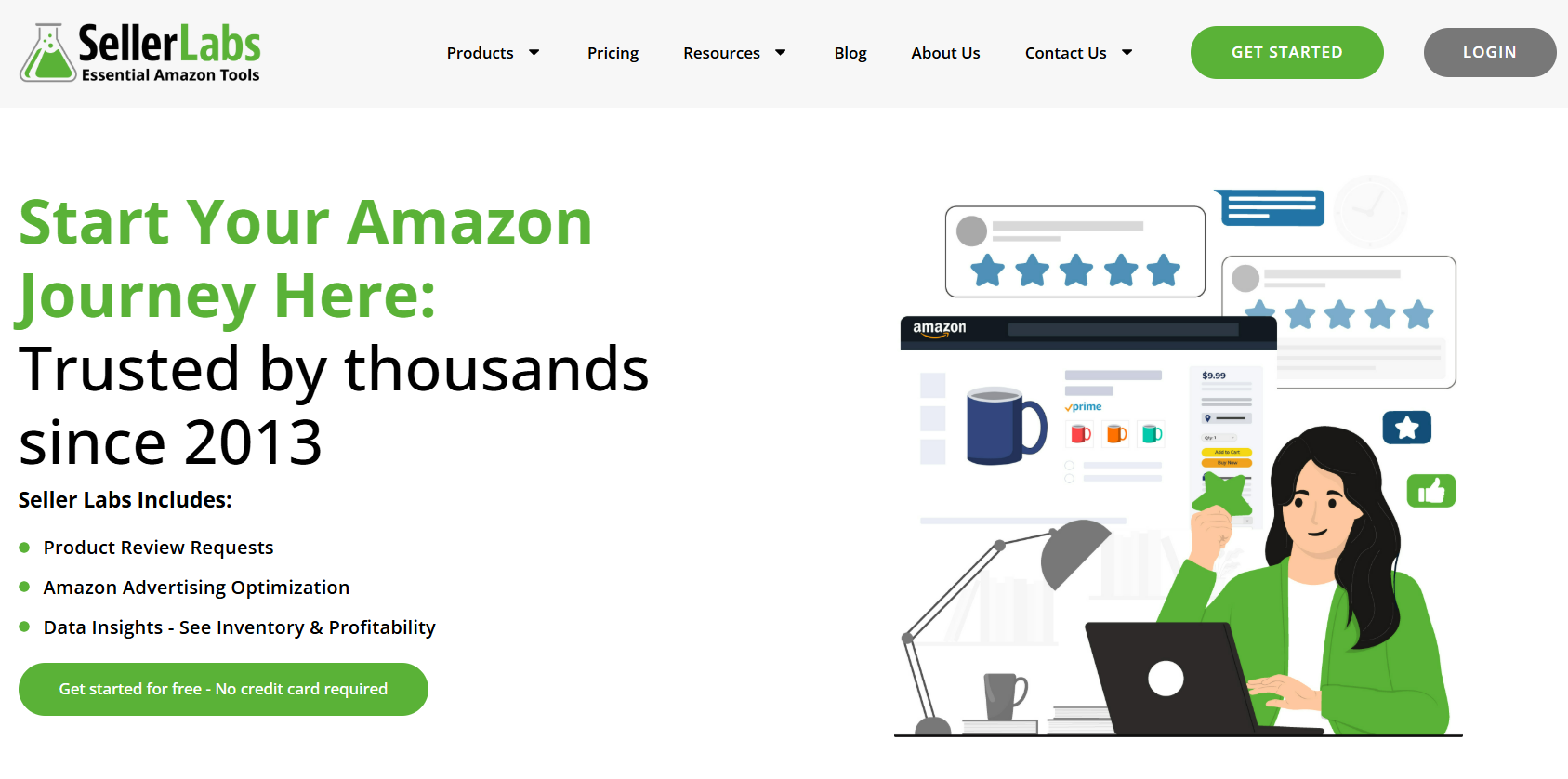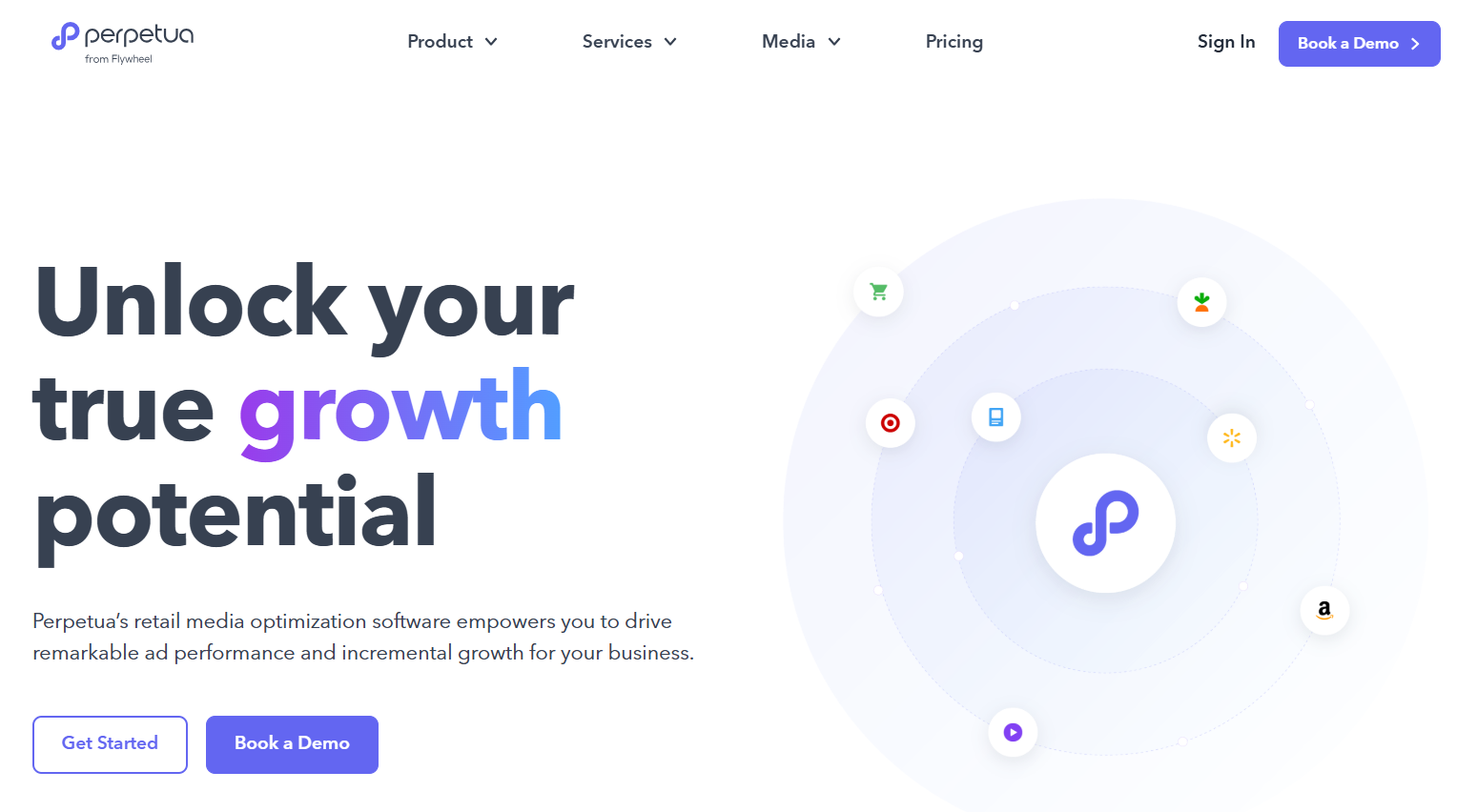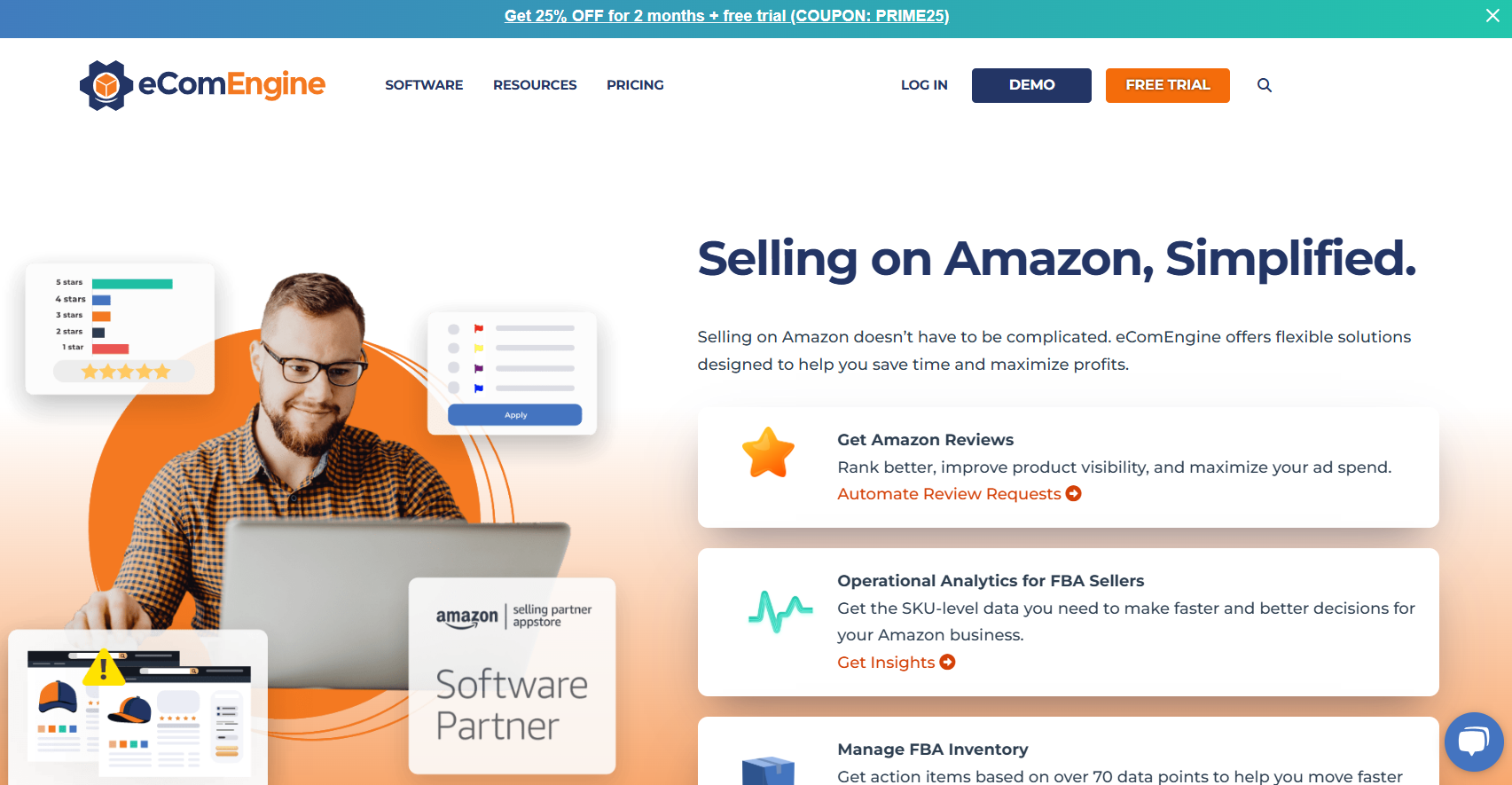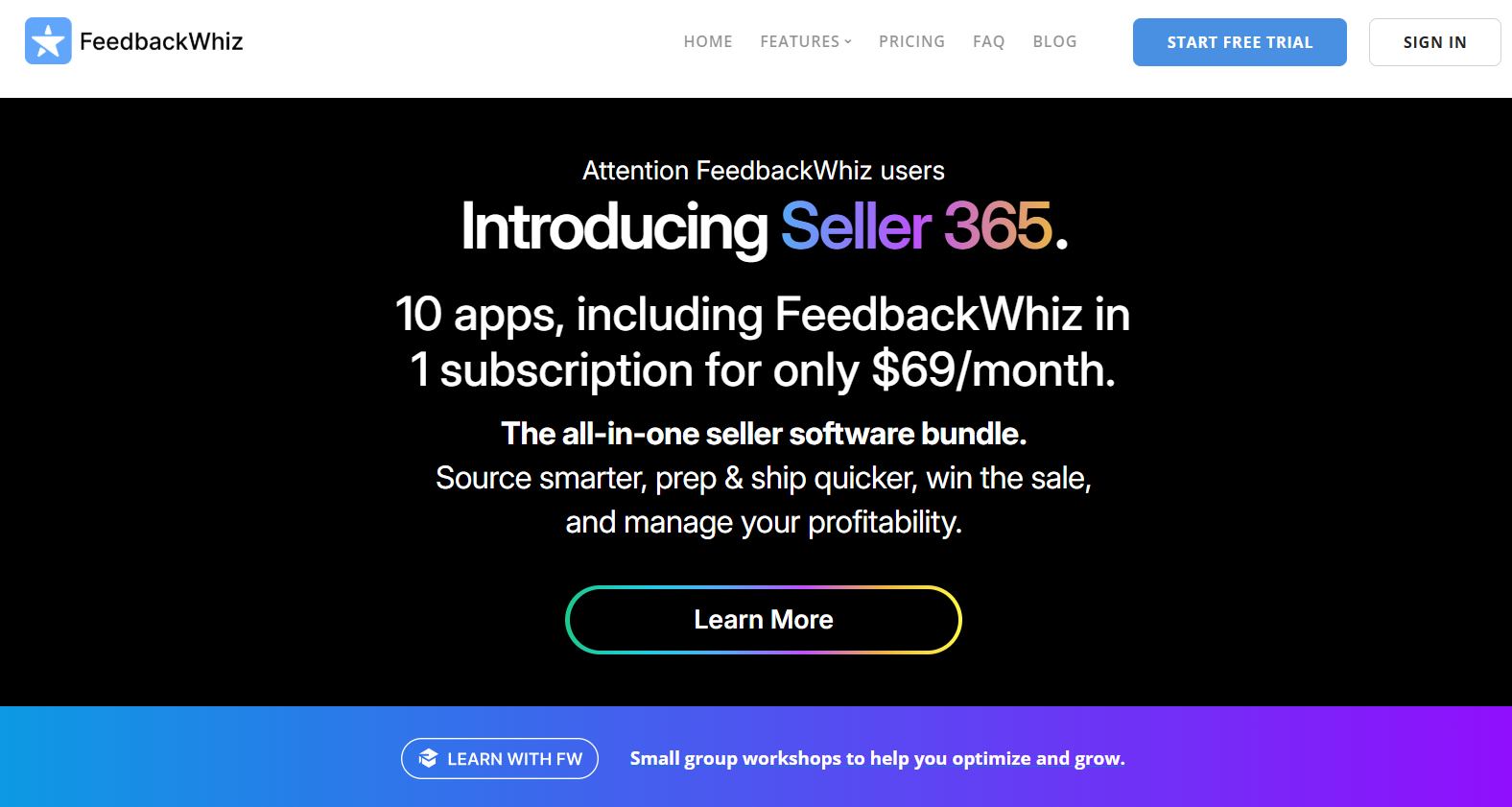Best Amazon Business Tools to Streamline and Scale Your Store
Running a successful Amazon business requires more than just a great product. With increasing competition and evolving customer expectations, the right set of tools can make all the difference. From listing optimization and keyword tracking to inventory management and profit analytics, Amazon sellers need a full-stack toolkit to stay ahead. In this guide, we explore the top Amazon business tools every seller should consider in 2025 to streamline operations, grow visibility, and maximize profits.
1. WisePPC
We provide a tool designed to help Amazon sellers automate, manage, and optimize their advertising campaigns with greater control and less manual work. Our system focuses on making campaign operations easier by offering automation rules for adjusting bids, managing budgets, and organizing keywords. Sellers can define conditions that automatically trigger actions based on performance metrics, which helps maintain consistent ad efficiency without needing constant oversight.
Our platform also allows users to create and manage keyword structures in a more organized way. By grouping keywords according to relevance and performance, we help improve campaign clarity and control. We support Sponsored Products, Sponsored Brands, and Sponsored Display ads. Users can also monitor key performance indicators like ACoS, CTR, and impressions through customizable dashboards. We aim to reduce complexity for sellers managing large portfolios or scaling up ad operations by making campaign workflows more predictable and data-driven.
Key Highlights:
- Automation for bid, placement, and budget adjustments
- Keyword grouping to improve campaign structure
- Custom rules based on performance thresholds
- Centralized dashboard for PPC performance tracking
- Supports Sponsored Products, Brands, and Display
Services:
- Amazon PPC campaign automation
- Rule-based bid and budget management
- Keyword structure organization
- Performance data monitoring and reporting
Contact and Social Media Information:
- Website: wiseppc.com
- Facebook: www.facebook.com/people/Wise-PPC/61573154427547
- LinkedIn: www.linkedin.com/company/wiseppc
- Instagram: www.instagram.com/wiseppc
2. SellerApp
SellerApp offers a range of tools for Amazon sellers to manage their business operations, including product research, keyword tracking, listing optimization, and PPC management. They provide access to data for analyzing product trends and tracking keyword performance, which helps sellers make informed decisions about what to sell and how to improve visibility.
Their platform supports campaign automation features and listing quality analysis, aiming to help sellers improve conversion rates and maintain consistent performance. They also offer free tools like profit calculators, Amazon fee breakdowns, and keyword tools that support sellers in daily operations without needing additional software.
Key Highlights:
- Product and keyword research tools
- Listing quality and optimization analysis
- Free tools for profit calculation and fee tracking
- PPC management and campaign tracking features
Contact and Social Media Information:
- Website: www.sellerapp.com
- E-mail: [email protected]
- Facebook: www.facebook.com/sellerapp
- Twitter: x.com/SellerApp_Inc
- LinkedIn: www.linkedin.com/company/sellerapp
- Instagram: www.instagram.com/sellerapp_insta
- Address: 4819 Bryant Mdws Dr, Spring, TX 77386, United States
- Phone: +1-737-225-3338
3. Helium 10
Helium 10 provides a wide suite of tools for Amazon sellers to manage product research, keyword tracking, listing optimization, inventory, and operations. Their platform includes features for reverse ASIN lookup, trend analysis, and market evaluation to help sellers identify competitive opportunities.
They also offer tools for inventory alerts, refund tracking, and follow-up email automation. Sellers can track keyword rankings over time and manage listings with suggestions for content and SEO improvements. Helium 10 also includes a profitability calculator and advertising tools to support budget decisions and performance tracking.
Key Highlights:
- Product research and reverse ASIN lookup
- Keyword rank tracking and trend analysis
- Listing optimization with SEO suggestions
- Inventory alerts and refund management
- Profit calculator and advertising support tools
Contact and Social Media Information:
- Website: www.helium10.com
- Facebook: www.facebook.com/Helium10Software
- Twitter: x.com/H10Software
- LinkedIn: www.linkedin.com/company/helium10
- Instagram: www.instagram.com/helium10software
4. SellerSprite
SellerSprite focuses on market analysis, product discovery, and keyword research. They help Amazon sellers track market trends, identify high-potential products, and optimize content based on search data. The platform offers keyword mining and demand analysis tools to support strategic decisions in listing and PPC planning.
In addition to research tools, they provide modules for tracking competitors, monitoring reviews, and assessing pricing strategies. This helps sellers understand shifts in customer behavior and competitor actions over time, allowing for data-based adjustments in operations.
Key Highlights:
- Market and product research tools
- Keyword demand and trend analysis
- Competitor and review monitoring
- Pricing and promotion tracking tools
Contact and Social Media Information:
- Website: www.sellersprite.com
- E-mail: [email protected]
- Facebook: www.facebook.com/sellersprite.us
- Twitter: x.com/SellerSprite_EN
5. Jungle Scout
Jungle Scout provides software that supports Amazon sellers with tools for product research, supplier sourcing, sales estimates, and keyword tracking. Their platform helps sellers identify potential products to sell, evaluate supplier data, and monitor historical sales trends across categories.
The platform also includes tools for managing reviews, optimizing listings, and tracking advertising performance. Sellers use the data to understand customer demand, forecast opportunities, and maintain consistent growth through structured decision-making.
Key Highlights:
- Product and sales trend tracking
- Supplier database and sourcing support
- Review and listing management tools
- Advertising analytics and keyword tracking
Contact and Social Media Information:
- Website: www.junglescout.com
- E-mail: [email protected]
- Facebook: www.facebook.com/amazonjunglescout
- Twitter: x.com/junglescout
- LinkedIn: www.linkedin.com/company/junglescout
- Instagram: www.instagram.com/junglescout_
- Address: 328 S. Jefferson St., Suite 1030 Chicago, IL 60661
6. Sellerboard
Sellerboard focuses on profit analytics and financial tracking for Amazon sellers. Their platform helps monitor net profit, margins, and operating expenses across product lines. It supports real-time tracking of sales, returns, and Amazon fees in a single dashboard.
They also offer features for PPC analysis, inventory forecasting, and alert management. Sellers can use the platform to reduce manual spreadsheet work and maintain a better understanding of product-level profitability over time.
Key Highlights:
- Real-time profit and cost tracking
- PPC analytics and performance reports
- Inventory forecasting and alert systems
- Dashboard for managing financial performance
Contact and Social Media Information:
- Website: sellerboard.com
- E-mail: [email protected]
- Facebook: www.facebook.com/sellerboard
- Twitter: x.com/sellerboard
- Instagram: www.instagram.com/sellerboard.official
7. SellerSnap
SellerSnap provides automated repricing tools for Amazon sellers using AI-driven strategies. Their platform focuses on dynamic pricing adjustments based on competition and buy box behavior. The goal is to help sellers stay competitive without constant manual changes.
They also include tools for profit tracking, sales data analysis, and inventory monitoring. Sellers can apply custom repricing rules or use built-in algorithms to manage product pricing in real time while maintaining profitability.
Key Highlights:
- Automated repricing based on competitor data
- AI-driven dynamic pricing strategies
- Profit and sales tracking features
- Inventory and performance monitoring
Contact and Social Media Information:
- Website: sellersnap.io
- Facebook: www.facebook.com/sellersnap.io
- Twitter: x.com/sellersnap_io
- LinkedIn: www.linkedin.com/company/seller-snap-inc.
- Instagram: www.instagram.com/sellersnap.io
- Address: 7455 Arroyo Crossing Parkway, Suite 220 Las Vegas, NV 89113, United States
- Phone: +1 (262) 735 5767
8. Analyzer.Tools
Analyzer.Tools offers keyword research, reverse ASIN lookup, and listing analysis for Amazon sellers. Their tools help evaluate search volume, keyword relevancy, and competitor performance. Sellers can use this information to build more effective listings and ad campaigns.
They also provide tracking tools to monitor keyword position over time and assess changes in ranking. By combining keyword data with listing optimization features, sellers can refine their content and increase discoverability within Amazon search.
Key Highlights:
- Keyword research and search volume data
- Reverse ASIN lookup and competitor analysis
- Listing content evaluation and keyword integration
- Keyword rank tracking over time
Contact and Social Media Information:
- Website: www.analyzer.tools
- E-mail: [email protected]
- Facebook: www.facebook.com/Analyzer.tools
- Twitter: x.com/Analyzertools
9. Pixelfy
Pixelfy provides Amazon sellers with a set of tools to generate advanced URLs for tracking external traffic and user behavior. These links are used mainly in off-Amazon campaigns, such as social media ads, email marketing, or influencer promotions. Sellers can customize these URLs with tracking parameters, keywords, and redirect options to collect data on how users engage with specific promotions.
The platform offers multiple types of links, including search-optimized URLs, add-to-cart links, and geo-targeted redirects. Sellers use these tools to create focused funnels that guide users toward Amazon product listings or offers. Detailed analytics help sellers measure the effectiveness of different traffic sources, enabling them to adjust strategies based on actual click performance.
Key Highlights:
- Custom URL generator with keyword and tracking support
- Multiple URL formats including add-to-cart and geo-links
- Click analytics for external traffic evaluation
- Useful for off-Amazon campaign performance tracking
Contact and Social Media Information:
- Website: pixelfy.me
- Facebook: www.facebook.com/pixelfy.me
- LinkedIn: www.linkedin.com/company/pixelfy-amazon
10. Seller Labs
Seller Labs provides a suite of tools for managing Amazon advertising, customer engagement, and business intelligence. Their advertising module allows sellers to manage Sponsored Products and Sponsored Brands, adjust bids, and monitor performance from a centralized dashboard. Keyword discovery features help identify new terms and search trends relevant to a seller’s products.
They also offer customer communication tools that automate messaging through Amazon’s Buyer-Seller Messaging system. These tools include templates, message timing rules, and filters based on order status. The platform supports review monitoring and alerting, which helps sellers respond to changes in customer feedback or potential issues more quickly.
Key Highlights:
- Amazon ad management with keyword discovery
- Campaign performance monitoring and bid adjustment
- Automated customer messaging and review tracking
- Custom templates and filters for buyer communication
Contact and Social Media Information:
- Website: www.sellerlabs.com
- Address: 999 Mansell Rd, Ste D Roswell GA, 30076
11. Perpetua
Perpetua offers a set of automation tools for managing Amazon advertising campaigns with minimal manual input. Their platform supports Sponsored Products, Sponsored Brands, and Sponsored Display ads across multiple marketplaces. Sellers can define performance goals such as target ACoS, and the platform adjusts bids and keyword targets accordingly in real time.
Perpetua also includes performance dashboards that provide metrics like impressions, clicks, and conversions. Sellers can analyze how each campaign contributes to overall ad spend and profitability. The platform enables goal-based automation for new product launches or scaling existing products while maintaining visibility into daily performance trends.
Key Highlights:
- Advertising automation across multiple ad types
- Goal-driven bidding and targeting system
- Real-time reporting on campaign metrics
- Supports campaign scaling and product launches
Contact and Social Media Information:
- Website: perpetua.io
- E-mail: [email protected]
- Facebook: www.facebook.com/perpetualabs
- Twitter: x.com/PerpetuaLabs
- LinkedIn: www.linkedin.com/company/perpetua-labs
- Instagram: www.instagram.com/perpetua.io
- Address: 36 Maplewood Ave Portsmouth, NH 03801
12. EcomEngine
EcomEngine develops software tools focused on feedback management, review requests, and inventory performance. Their platform automates the process of requesting reviews and seller feedback in compliance with Amazon’s policies. It supports scheduling based on order events, and filters can be applied to exclude refunded or delayed orders.
Their inventory tools help sellers track stock levels, estimate restock needs, and manage purchase orders with suppliers. Forecasting tools support demand planning and help reduce overstock or stockout risks. The system integrates with Amazon’s inventory data to keep sellers informed about product availability and sales velocity.
Key Highlights:
- Review request automation with order-based filters
- Feedback tracking tools for customer satisfaction
- Restock forecasting and supplier order management
- Inventory tracking integrated with Amazon systems
Contact and Social Media Information:
- Website: www.ecomengine.com
- Twitter: x.com/eComEngine
- LinkedIn: www.linkedin.com/company/ecomengine-llc
- Address: 14321 Winter Breeze Drive Suite 121 Midlothian, VA 23113
- Phone: 800-757-6840
13. FeedbackWhiz
FeedbackWhiz offers tools to manage buyer communication, monitor product reviews, and track order-related events. Their messaging features allow sellers to create custom templates and set up automation rules based on shipping, delivery, or refund events. The platform ensures all messages comply with Amazon’s communication guidelines.
The system also provides real-time review monitoring and alerting. Sellers can track review changes at the product level and receive notifications for new ratings, helping them respond to issues more efficiently. Additional reporting features help analyze customer sentiment over time and identify trends in product feedback.
Key Highlights:
- Order-based message automation with custom templates
- Review monitoring with change alerts and trend tracking
- Tools for analyzing buyer sentiment and feedback trends
- Compliant messaging system for post-purchase communication
Contact and Social Media Information:
- Website: www.feedbackwhiz.com
- E-mail: [email protected]
- Facebook: www.facebook.com/feedbackwhiz
- Twitter: x.com/feedbackwhiz
- Instagram: www.instagram.com/feedbackwhiz
- Phone: +1 (408) 724-9521
14. Viral Launch
Viral Launch offers a full set of tools for product research, listing optimization, keyword tracking, and competitor analysis. Their platform includes a reverse ASIN lookup tool, keyword research module, and product discovery feature to help sellers evaluate market demand and spot new opportunities.
Sellers can also use the platform to optimize their listings with keyword suggestions and content analysis. The listing analyzer scores product detail pages based on relevance, completeness, and keyword usage. Additional tools allow sellers to track competitors’ keyword rankings, helping them respond to market shifts and adjust their strategy accordingly.
Key Highlights:
- Product and keyword research tools with trend insights
- Reverse ASIN lookup and market analysis
- Listing analyzer with keyword and content feedback
- Competitor monitoring for keyword positions and rankings
Contact and Social Media Information:
- Website: viral-launch.com
- E-mail: [email protected]
- Facebook: www.facebook.com/virallaunchamazonsoftware
- Twitter: x.com/viral_launch
- LinkedIn: www.linkedin.com/company/viral-launch
- Instagram: www.instagram.com/viral_launch
- Address: 12110 Sunset Hills Rd Reston, VA 20190 United States
15. Feedvisor
Feedvisor provides advanced tools for pricing optimization, advertising management, and business intelligence. Their algorithmic repricer adjusts product prices based on competition, inventory, and buy box performance, aiming to keep listings competitive while preserving margins. Sellers can set parameters to match their pricing strategy and risk level.
The platform also includes advertising tools for campaign creation, targeting, and reporting. Sellers can manage ad spend, monitor ACoS, and evaluate campaign results in real time. Business intelligence dashboards provide detailed insights into operational performance, including inventory turnover, cost structure, and profitability.
Key Highlights:
- Algorithmic repricing engine for competitive pricing
- Ad campaign management with targeting and performance metrics
- Business intelligence tools for operational reporting
- Custom pricing strategies based on inventory and competition
Contact and Social Media Information:
- Website: feedvisor.com
- E-mail: [email protected]
- Facebook: www.facebook.com/feedvisor
- Twitter: x.com/feedvisor
- LinkedIn: www.linkedin.com/company/feedvisor
- Instagram: www.instagram.com/feedvisor_
- Address: 122 Grand Street, Suite 23, New York, NY 10013
- Phone: 347.803.2758
Conclusion
Managing and growing an Amazon store involves many moving parts, from advertising and pricing to inventory, customer feedback, and competitive research. The tools outlined in this article support sellers in handling these tasks more efficiently by offering automation, performance tracking, and data-driven insights.
By integrating the right set of business tools, sellers can simplify daily operations, respond more effectively to market changes, and make informed decisions. Each tool serves a specific role, and choosing the right combination depends on individual goals, business size, and operational needs.
Join the WisePPC Beta and Get Exclusive Access Benefits
WisePPC is now in beta — and we’re inviting a limited number of early users to join. As a beta tester, you'll get free access, lifetime perks, and a chance to help shape the product — from an Amazon Ads Verified Partner you can trust.
 No credit card required
No credit card required
 Free in beta and free extra month free after release
Free in beta and free extra month free after release
 25% off for life — limited beta offer
25% off for life — limited beta offer
 Access metrics Amazon Ads won’t show you
Access metrics Amazon Ads won’t show you
 Be part of shaping the product with your feedback
Be part of shaping the product with your feedback











